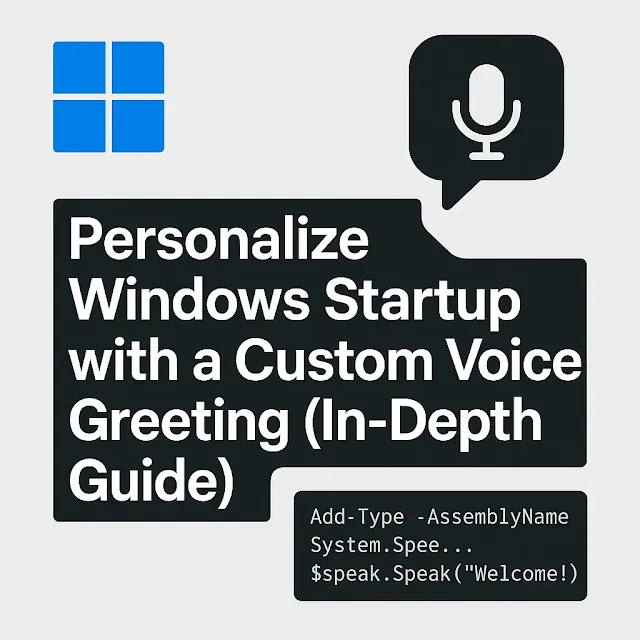Ever wished your computer could greet you like Jarvis from Iron Man when it boots up?
With just a few lines of script, you can make your Windows PC say anything you want — from motivational quotes to reminders, jokes, or your name — every time it starts. No extra software, no registry tweaks, and no risk involved.
This guide is updated for 2025 and works across Windows 7, 8, 10, and 11.
🧩 What You’ll Learn in This Tutorial
- How to write a VBScript that speaks
- How to trigger it automatically on startup
- How to customize the message, voice, and even add multiple messages
- How to troubleshoot and manage startup behavior
🔐 Safe, fun, and fully reversible.
🧰 What You Need
- A Windows PC (any version from Windows 7 to 11)
- Notepad or Notepad++
- 5 minutes of time
- Your imagination!
🛠️ Step-by-Step Guide to Creating a Custom Voice Startup Script
We’ll walk through this snippet by snippet.
📝 Step 1: Create a Basic VBScript That Speaks
Open Notepad and enter the following code:
Dim speak
Set speak = CreateObject("sapi.spvoice")
speak.Speak "Hello, welcome back!"
🔍 What’s Happening Here?
CreateObject("sapi.spvoice"): This uses Windows' built-in Speech API (SAPI) to access the text-to-speech engine..Speak "...": This line is where your message goes — spoken aloud by your PC at runtime.
You can replace the string with any sentence you want, like:
speak.Speak "Good morning, Anika. Your system is ready to go."
💾 Step 2: Save It as a .vbs Script File
Now let’s save it the right way so Windows can execute it.
- In Notepad, click File > Save As
- In Save as type, select All Files
- Name it something like:
startup-voice.vbs - Make sure the file extension is
.vbsand not.txt
✅ Correct:
startup-voice.vbs
❌ Incorrect:startup-voice.vbs.txt
🚀 Step 3: Add Your Script to Windows Startup Folder
This ensures the script runs automatically every time your computer starts.
- Press Win + R to open the Run window
- Type:
shell:startup
- Hit Enter – this opens the Startup folder
- Copy your
startup-voice.vbsfile into this folder
That’s it! Your voice greeting will now run on every login.
🔧 Advanced Customizations
You can go further than just one sentence.
✅ Add Multiple Messages
Want your computer to say multiple lines? No problem.
Set speak = CreateObject("sapi.spvoice")
speak.Speak "Good morning, Sam."
speak.Speak "Here’s your reminder: Backup your code today."
speak.Speak "Stay focused and crush those bugs!"
Each .Speak line will be read in order.
🎛️ Change Voice (If Multiple Are Installed)
You can use a different voice if your system supports it:
Set speak = CreateObject("sapi.spvoice")
Set voice = speak.GetVoices.Item(1) ' Try changing the index
speak.Voice = voice
speak.Speak "Welcome to your machine!"
💡 Use
GetVoices.Countin a loop to check how many voices your system has.
⏱ Add a Delay Before Speaking
You can delay the voice using WScript.Sleep:
Set speak = CreateObject("sapi.spvoice")
WScript.Sleep 3000 ' Delay in milliseconds (3 seconds)
speak.Speak "System loaded. Welcome!"
Useful if your system needs a moment before speaking.
🔐 Optional: Disable Default Startup Sound (Windows 7/8 Only)
To avoid overlap with the Windows startup chime:
- Open Control Panel > Sound
- Click the Sounds tab
- Uncheck Play Windows Startup sound
- Click Apply > OK
💡 For Windows 10/11, the startup sound is off by default — this step is optional.
🎯 Real-World Use Cases
This small trick can help you:
Stay motivated:
“Today’s the day you deploy your app!”
Remember habits:
“Don’t forget to stand up every hour.”
Build a fun routine:
“Your digital assistant is online.”
Add humor:
“Why are you up so early? Did the servers crash?”
💡 Best Practices & Tips
- Keep your messages short and clear
- Avoid using special characters or non-English words (SAPI might misread them)
- Use this trick in shared PCs for custom messages per user (different
.vbsper profile) - Test your script manually first before moving it to startup
🌐 SEO & Digital Experience Impact
While this script doesn't directly affect SEO, it enhances user experience, which indirectly contributes to brand perception, especially if you're building tools or demos for public-facing systems.
It also shows clients and teammates your ability to automate tasks and personalize interactions — a soft skill in high demand.
📌 Conclusion
You’ve just learned how to add a personal touch to your Windows system with a simple voice script that runs at startup. Whether it's a morning greeting, reminder, or joke — your PC now feels a little more alive.
💬 Try it out and let us know what message you’re using!
👉 Want more cool scripts like this?
Check out our Automation & AI tutorials — from voice bots to file organizers.












0 Comments